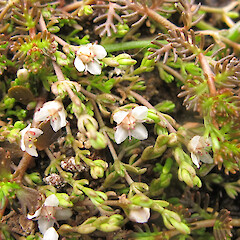Crassula sinclairii
Common name
Sinclair’s stonecrop
Synonyms
Tillaea sinclairii Hook.f., T. novae-zelandiae var. obtusa Kirk, T. novae-zelandiae Petrie
Family
Crassulaceae
Flora category
Vascular – Native
Endemic taxon
Yes
Endemic genus
No
Endemic family
No
Structural class
Herbs - Dicotyledons other than Composites
NVS code
The National Vegetation Survey (NVS) Databank is a physical archive and electronic databank containing records of over 94,000 vegetation survey plots - including data from over 19,000 permanent plots. NVS maintains a standard set of species code abbreviations that correspond to standard scientific plant names from the Ngä Tipu o Aotearoa - New Zealand Plants database.
CRASIN
Chromosome number
2n = 30, 56
Current conservation status
The conservation status of all known New Zealand vascular plant taxa at the rank of species and below were reassessed in 2017 using the New Zealand Threat Classification System (NZTCS) – more information about this can be found on the NZTCS website. This report includes a statistical summary and brief notes on changes since 2012 and replaces all previous NZTCS lists for vascular plants.
Please note, threat classifications are often suggested by authors when publications fall between NZTCS assessment periods – an interim threat classification status has not been assessed by the NZTCS panel.
- Conservation status of New Zealand indigenous vascular plants, 2017 . 2018. Peter J. de Lange, Jeremy R. Rolfe, John W. Barkla, Shannel P. Courtney, Paul D. Champion, Leon R. Perrie, Sarah M. Beadel, Kerry A. Ford, Ilse Breitwieser, Ines Schönberger, Rowan Hindmarsh-Walls, Peter B. Heenan and Kate Ladley. Department of Conservation. Source: NZTCS and licensed by DOC for reuse under the Creative Commons Attribution 4.0 International licence.
2017 | Not Threatened
Previous conservation statuses
2012 | Not Threatened
2009 | Not Threatened
2004 | Not Threatened
Distribution
Endemic. New Zealand: North, South, Stewart and Chatham Islands.
Habitat
Coastal to alpine, Aquatic in slow flowing rivers, creeks, ponds, tarns and lakes, and also in brackish lagoons, and waterways. Usually in places where it is submerged for most of the year.
Wetland plant indicator status rating
Information derived from the revised national wetland plant list prepared to assist councils in delineating and monitoring wetlands (Clarkson et al., 2021 Manaaki Whenua – Landcare Research Contract Report LC3975 for Hawke’s Bay Regional Council). The national plant list categorises plants by the extent to which they are found in wetlands and not ‘drylands’. The indicator status ratings are OBL (obligate wetland), FACW (facultative wetland), FAC (facultative), FACU (facultative upland), and UPL (obligate upland). If you have suggestions for the Wetland Indicator Status Rating, please contact: [Enable JavaScript to view protected content]
OBL: Obligate Wetland
Almost always is a hydrophyte, rarely in uplands (non-wetlands).
Detailed description
Perennial herb forming small to large extensive finely filamentous thread-like mats; stems almost prostrate except for slightly ascending tips, freely rooting at nodes, much-branched. Leaves connate at base, 0.5-2.0 × 0.2-0.5 mm, c.0.2 mm thick, lanceolate-oblong, lanceolate-elliptic or oblanceolate, flattened above, strongly convex below; apex acute. Flowers solitary in lf axils, star-like, 4-merous, sweetly fragrant, 2.5-3.5 mm diameter; pedicels 0.5-3.0 mm long, elongating little at fruiting. Calyx lobes 0.4-0.6 × c.4 mm, broadly ovate, obtuse or subacute. Petals 1.0-1.8 × 0.5-0.9 mm, broadly ovate or triangular-ovate, white, often flushed pink, obtuse, much > calyx. Scales c.0.5 mm long, oblong-cuneate or oblanceolate. Follicles smooth. Seed 0.30-0.45 mm long.
Flowering
October - March
Flower colours
Red/Pink, White
Fruiting
November - June
Life cycle
Minute follicles are dispersed by wind and water and possiblty also by attachment (Thorsen et al., 2009).
Propagation technique
Easily grown from rooted pieces but difficult to maintain and not especially attractive.
Etymology
crassula: From the Latin crassus ‘thick’, meaning ‘rather thick’
sinclairii: After Sinclair (c. 1796–1861). Colonial Secretary and naturalist.
Where To Buy
Not commercially available
Attribution
Description modified from Webb et al. (1988)
References and further reading
Webb, C.J.; Sykes, W.R.; Garnock-Jones, P.J. 1988: Flora of New Zealand. Vol. IV. DSIR Botany Division, Christchurch.
Thorsen, M.J.; Dickinson, K.J.M.; Seddon, P.J. 2009: Seed dispersal systems in the New Zealand flora. Perspectives in Plant Ecology, Evolution and Systematics 11: 285-309.










